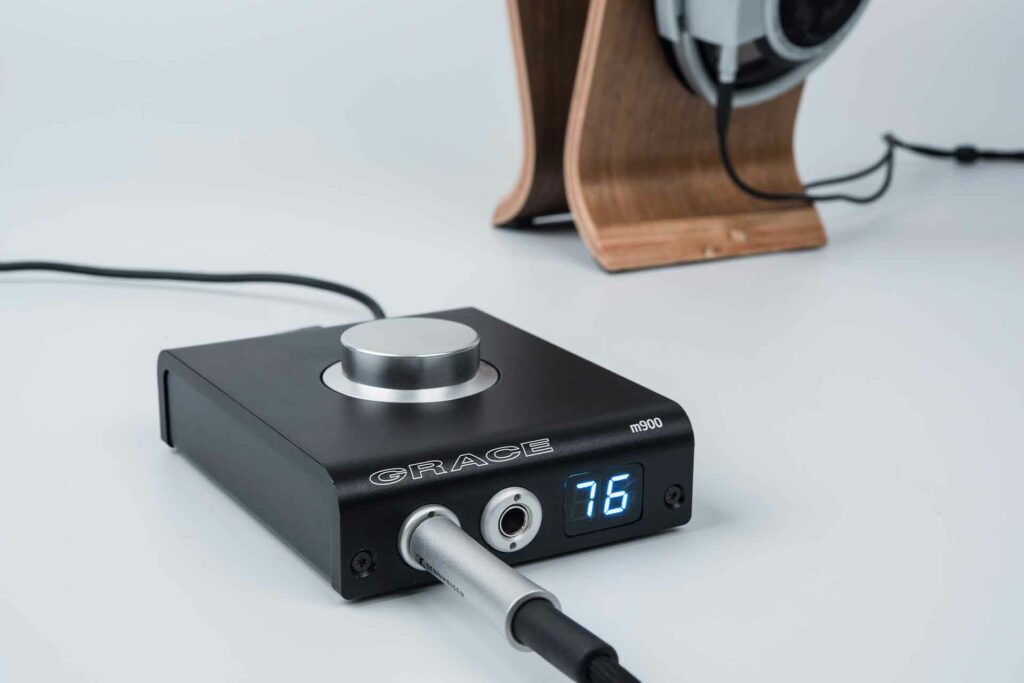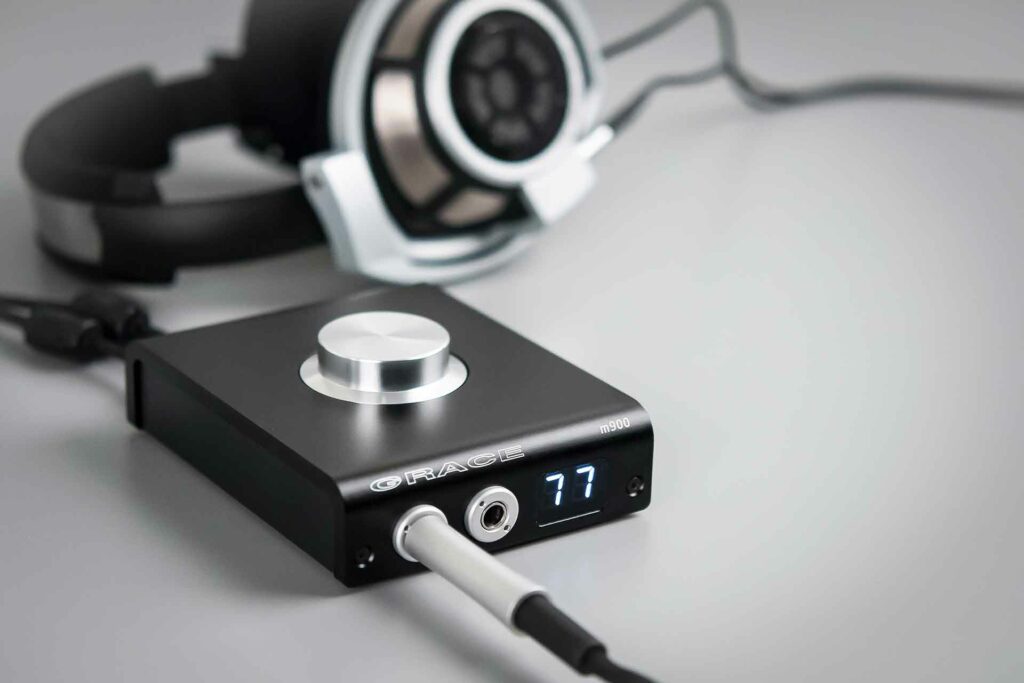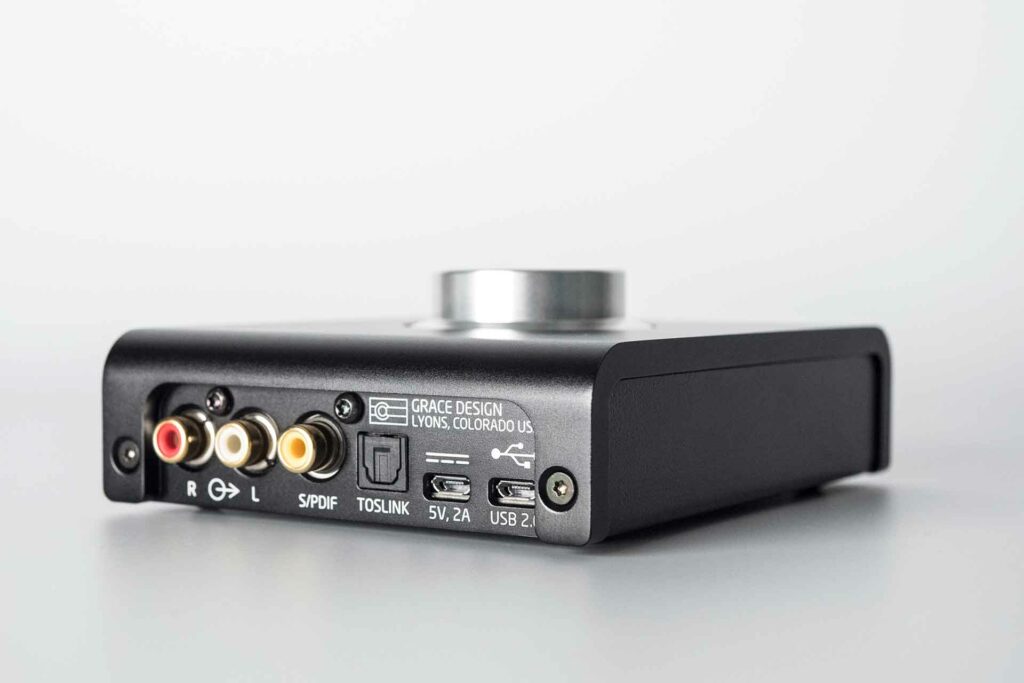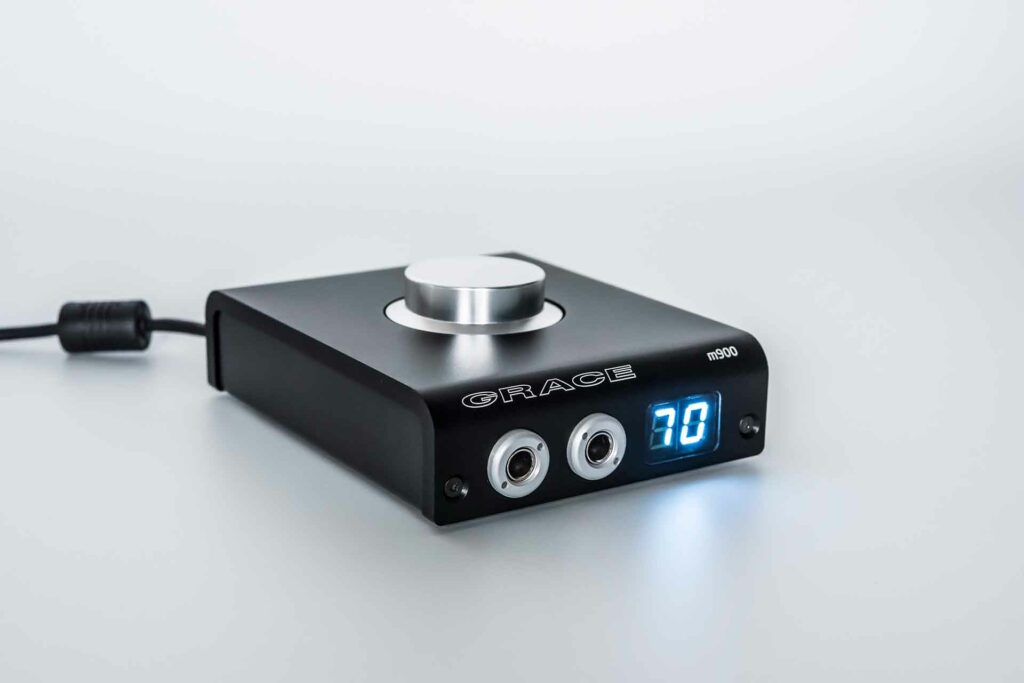An audiophile digital-to-analog converter (DAC) is a device that converts a digital signal into an analog waveform that your speakers can produces and your ears will ultimately understand. DACs are in everything these days. They are ubiquitous devices that perform to their technical specifications, often well beyond what is required for audiophile purposes. Modern DAC chips are inexpensive and virtually interchangeable. But the electronics the DAC chips are surrounded by that handle the inputs, outputs, volume control, signal processing, software control, output buffering, clocking, and even what supplies the power are ultimately what determines the level of a DAC’s ultimate performance, and boy is there a range on the prices for DACs in the market, from very affordable to products costing well into the tens of thousands of dollars per solution.

Grace Design, who has won multiple awards for work around microphone preamplifiers, monitor controllers, and niche products for the pro audio recording industry, dips an occasional toe into the world of high-end audio. The Grace Audio m900 DAC/headphone amplifier/preamp is one such dip, and like every other award-winning piece Grace has meticulously engineered, the m900 does not fall far from the family tree thanks to some seriously robust technology surrounding a very capable DAC chip.
What Makes the Grace Design m900 DAC Special?
- The 32-bit AKM 4490 DAC chip supports up to 384kHz PCM, and 256x DSD, and just about every digital audio format in between. This DAC chip is shared with their large monitor controllers used in the finest music recording and mastering gear.
- The m900 is still considered a monitor controller, and is built for the highest-quality signal reproduction possible. The USB input is asynchronous, which eliminates USB jitter (distortion). The coaxial and Toslink digital connections are purposefully designed for not only monitoring (known as serious listening in our audiophile world), but to interface with digital audio workstations for mastering high-fidelity music.
- The m900 has a distinctive power supply that allows it to be run from USB, or a higher-current dedicated power source. The m900 can be taken anywhere and can run in “low power” mode when simply plugged into any USB device. Add the included power supply to the second USB input that is only used to supply high current power, and the m900 automatically switches to “high power” mode to deliver the highest quality output to an amplifier, or drive the most power-hungry headphones.
- In addition to being an extremely high-quality DAC, the Grace Audio m900 is a tremendously useful headphone amplifier, with a distinctive feature designed to simulate an acoustic listening environment through headphones. This feature, known as crossfeed, is defeatable, however it helps overcome the traditional shortfalls of headphone listening, such as the lack of environmental spatial queues one gets when the speakers are an inch from the eardrums.
- She’s a brick house… The build quality of the m900 is incredible at its price point. The m900 is also made in Lyons, Colorado.
- No gimmicks are found anywhere in the m900. The m900 is about as utilitarian as it gets. This may be a weakness for some (we will get to this); however, it is strictly the bare-bones of what is needed to perform, and is extensively tested. Detailed specs from Grace Design are available, because there is nothing to hide about the m900’s performance.

Why Should You Care About the Grace Design m900 DAC?
Anytime a company who prides themselves on their meticulous detail decides to dabble in affordable hi-fi, one of two things happen. A majority of the time, the product ends up being a mediocre-performing money grab, playing on people’s need to brag about owning a specific brand. On rare occasions, the right company, like Grace Design, will take their relentless pursuit of great sound to make good music accessible for all, simply because it is the right thing to do.
The Grace Audio m900 represents one of the primary reasons I decided to enter audio journalism. There are so many good, budget components that perform well. Finding the few components that rise way above and sharing them with everyone is in harmony with my personal mission of bringing good music to everyone. The m900 is an important piece of equipment that should seriously be considered.
That said… there are always asterisks. The Grace Design m900 is a $650 piece of equipment, and for some, where perfection had to be compromised to meet the price point, it may lack some visual appeal.

Some Things You Might Not Like About the Grace m900 DAC
- There are a lot of features and options and a tiny display to figure them all out. Remember the part where I lauded the lack of gimmicks? Here is the flip-side to that coin: The setup of the m900 is difficult, even for the tech-savvy audiophile. The dual-digit display uses strange characters to convey the settings information, and one mistake could mean less than desirable sonic quality that can be falsely attributed to the m900’s performance. I found myself having to verify my settings three times over to assure I did not miss a detail.
- There are no balanced outputs. Since the m900 has a volume control and acts as a preamp, the icing on the cake for the m900 would certainly have been to have balanced pre-outs.
- The m900 is portable, but it’s not that portable. It’s bulky and the inputs are uncovered, which leaves them prone to dust, pocket lint, or whatever else can find its way into the unit’s orifices. The large control knob on top (which is functionally awesome) can be accidentally pressed, plunging the user into a settings disaster, or accidentally cranking their headphones to head-exploding levels if turned while looking for a piece of gum at the bottom of the bag where the m900 is residing.
- There is no remote control included with the Grace Audio m900 DAC. If the m900 will be utilized as the volume control, be prepared to leave the listening position every time you want to dial things in a bit.
Listening to the Grace Audio m900 DAC…
I have liked Billie Ellish since she emerged from the darkness with her album When We All Fall Asleep, Where Do We Go? “When the Party’s Over” is a melancholy track that highlights Billie’s vocals in a choral arrangement, blended with synthesized bass and piano. There are other embellishments throughout the song that take place in all sorts of dimensions through the soundstage. It is worth noting, too, Billie’s brother Phineas is an insanely brilliant recording engineer who understands that silence can be just as good of a recording feature as the instruments themselves.
Turning to Qobuz, utilizing the USB input in “high power” mode, I queued up the hi-res version of “When the Party’s Over.” Immediately I was grabbed by the quiet, completely holographic soundstage and three-dimensional vocals. The piano had sophisticated, realistic harmonic texture, which was a first for me at the sub-kilo buck level of DAC. The thunderous, and extremely deep bass line that reaches down below 30 Hz was controlled and did not come at the expense of the music above it, which preserved Billie’s haunting vocals.
The Grace Audio m900 has a sound of its own. A little signature that I found to be more additive than detractive. Similar to the discontinued Grace Design m920 I fell in love with long ago, the m900 has a gentle touch. I found this quality to be present in all of the digital filtering selections. These filters, which are selectable, give you some control over how the analog waveform, is reconstructed, and involve some roll-off of higher frequencies, as well as some delay. I ultimately settled on filter three, which is sharp roll-off, minimum phase, but if that sound isn’t for you, you can also tinker with filters that more accurately reconstruct an impulse, as well as those that roll off a little slower, and different combinations thereof.
Admittingly, I am not a headphone guy. I prefer listening in-room through loudspeakers. However, the m900 is a tremendous headphone amplifier, so I blew the dust off my Grado SR80s and had a quick go-round with “When the Party’s Over.” I never felt the need to turn off the crossfeed feature. I was enamored with the headphone performance of the m900 and the crossfeed made the listening seem like far more of an in-room experience, rather than listening in a bottle, which is what I typically experience with headphones. This is where the first inkling came that I may need to add the m900 to my bedroom system as my DAC/preamp, as it would also allow me to listen to headphones and not disturb my better half.
Moving on: Leonard Cohen did a clever thing knowing his time was short back in 2016. He set aside nine tracks for his son, Adam, to release after his death. These tracks make the album called Thanks for the Dance. I can be a sentimental son-of-a-sea-cook. The dark lyrics, pure recording, and gravelly voice of Leonard Cohen absolutely tear into my soul when the title track of this album is reproduced well.
The Grace Audio m900, sounded to me like a DAC well up over the $3,000 price point in terms of resolution, space, and sophistication. “Thanks For the Dance” is another song that utilizes silence as much as the music itself, and the vast emptiness of the soundstage when it needed to be empty was breathtaking. Texture and dynamic range were all captured strongly enough to feel the m900’s performance was edging on top-tier; however, it did fall short of the Bricasti M1. A small part of me was glad it did, or I would be put in the position of trying to explain why a $650 DAC sounds like a $12,000 DAC. The m900 did have superior performance when compared to the $1,600 Parasound Halo P6 preamp/DAC (read the review), though.
To assure due diligence was done, I put on the CD of Thanks for the Dance utilizing the SPDIF input. The performance was missing a little around the edges of each instrument, however this is expected since it was a 16-bit/44kHz recording, and not the high resolution 24-bit/44kHz version on Qobuz. Otherwise, there was nothing to be missed using a silver-disc-spinner into the Grace Audio m900.
Does the Grace m900 DAC Have Any Resale Value?
Take good care of the m900 and it will take care of you. It is backed by Grace’s five-year, transferrable warranty, and is not typically discounted through distribution. Grace seems to have an interesting distribution strategy, and runs their profit margins tight by hi-fi standards. This leaves little wiggle-room for heavily discounted product. I would estimate the m900 retaining 60 to 70 percent of its $650 selling value in the used market within the warranty period. Why would you get rid of it, though?
Who Is the Competition for the Grace Design m900 DAC?
The Grace Design m900 is a unique DAC in that it sacrifices creature comforts for all-out sonic performance. At $549, the Cambridge Audio DacMagic 200M (buy at Crutchfield) is a feature-packed DAC that is more typical of what one would expect to see south of $1,000. The DacMagic 200M is user-friendly and offers refined, high-end looks. Ease of use, enhanced connectivity, and a higher quality interface makes the DacMagic 200M an option to consider for those willing to sacrifice a little performance for enhanced connectivity and features.
If you want to make a complete step-up in performance from the m900, be prepared to open the wallet. At $2,299, you can find a Schiit Audio YGGDRASIL+ in your system. There is some loss of functionality, along with the devastating headphone section of the m900, however the YGGDRASIL+ is the first DAC I can think of that would be any sort of better in a significant enough sonic fashion to justify the price-jump.

Final Thoughts on the Grace Design m900 DAC
I have made the decision to add the Grace Audio m900 to my bedroom system. There is a secondary motive, too, and that is to use the m900 as a litmus tests for other entry-level DACs. Though it is not perfect, and a little user-clunky, I think the Grace Design m900 represents a diamond in the rough in terms of no-nonsense performance at an incredible price of $650.
As an audio journalist, it can be daunting, trying to work through equipment reviews, figuring out how to have our valued readers understand where any given piece of equipment sits in terms of performance. Products like the Grace Design m900 make the journey worthwhile, and are rejuvenating for the musical soul in its desire to share the experience of great music with everyone.




Nice review. The Boston Symphony has won several “Best-Engineered Classical Recording” Grammys, using mic preamps and monitor controllers from Grace Design. I have recommended Grace Design equipment to my sound-installation clients (churches, performance spaces, etc.) for at least 25 years.
Thank you, John, and Thank you for turning me on to Grace all those years ago. Working with them was a pleasure, too.